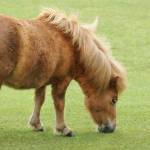Preserving Winter Pastures

An old adage goes something like this: You can have pretty green pastures and horses, but you can’t have both at the same time.
This might be especially true in winter when dormant plants aren’t putting out new growth and cloudy, rainy days keep soils saturated. Horses turned out on winter fields can quickly churn the top layer of ground into a morass of slippery mud complete with trampled manure and pockets of standing water. When spring rolls around, the only thing left to grow is a diverse crop of opportunistic weeds.
How can horse pastures survive the winter season in good condition? The best management is to keep horses off of wet winter fields, but if this is not practical, property owners can follow these steps to minimize damage.
- Begin the winter with healthy pastures. Schedule the last mowing so that plants have time to grow a bit more before entering winter dormancy. Ask agricultural agents in your area about the proper schedule for the application of seed, fertilizer, and weed control products.
- Keep horses out of fields when the ground is very wet. On drier days, turn out horses in pairs or small groups for short periods of time rather than allowing full turnout.
- Put hay in the field in several small piles, preferably not right next to fences and gates. Horses will still graze winter pastures, but instead of biting off the upper parts of growing plants, they tend to pull entire dormant plants completely out of the ground. If hay is offered in the pasture, this damage is somewhat minimized.
- If possible, create one or more sacrifice paddocks where horses can be turned out when the ground is too wet to allow safe access. This should be large enough for horses to move around freely and should not be crowded with too many horses. Size will be determined by the number of horses using the paddock at one time, but each horse should have at least 300 to 400 square feet of space. If space is limited, horses can be rotated through a single paddock so that each one has a few hours out of the stall during the day.
- Consider adding material to the part or all of the paddock to protect the ground surface and avoid mud. This can be sand, compacted crushed rock, wood chips, or rubber mats, shreds, or paving blocks. The surface should be several inches deep, non-slippery, and fairly easy to clean. Loose material like wood chips will break down slowly, and more material will need to be added from time to time. Think about using something quite durable, such as rubber mats, near gates and water supply where traffic will be heaviest.
- Remove manure as needed, at least once a day but more often if the paddock gets frequent use.
- If horses have been kept off pasture all winter, remember to introduce grazing gradually in the spring, beginning with brief periods several times a day and lengthening the hours until the horses can be turned out all the time. Continue to offer hay in the stall and in the field. This gradual reintroduction allows the horse’s digestive tract to adapt slowly to the change in diet. For horses susceptible to digestive disturbances related to changes in pasture quality, choose EquiShure to support the hindgut.








